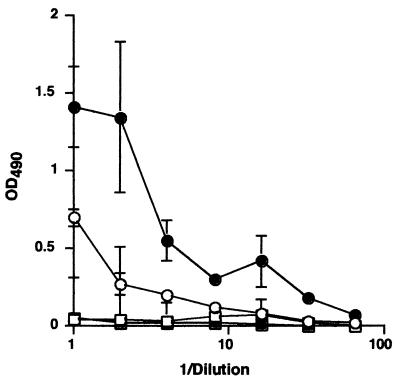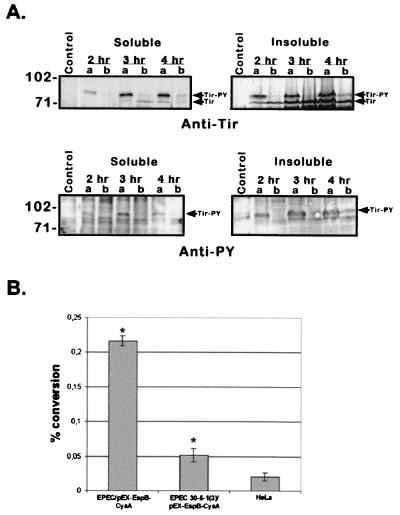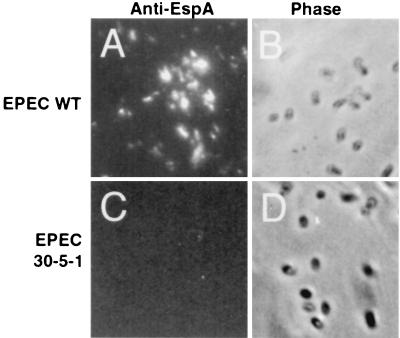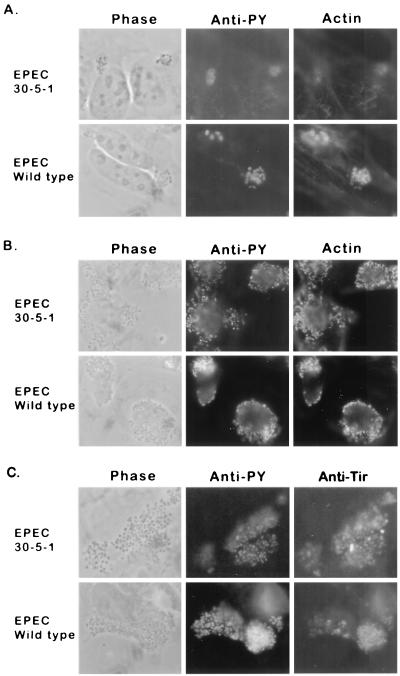Abstract
Enteropathogenic Escherichia coli (EPEC) strain 30-5-1(3) has been reported to form attaching and effacing (A/E) lesions without Tir tyrosine phosphorylation. In this study, we show that 30-5-1(3), which has a transposon insertion within the sepZ gene, forms wild-type A/E lesions including Tir tyrosine phosphorylation, but at a slower rate. A/E lesion formation by 30-5-1(3) occurs without detectable secretion of Tir or other EPEC Esp secreted proteins.
Enteropathogenic Escherichia coli (EPEC) is a major cause of infantile diarrhea in the developing world (17). EPEC colonizes the small intestine and requires intimate attachment to the host epithelium for full virulence. Intimate attachment leads to the formation of attaching and effacing lesions (A/E lesions), which involve the degeneration of the epithelial brush border, and the formation of actin-rich pedestals within the host cell beneath adherent EPEC (13, 16). A/E lesion formation is dependent on translocation of the bacterial protein Tir (translocated intimin receptor; formerly called Hp90) to the host cell membrane, where it is tyrosine phosphorylated and serves as a receptor for the EPEC outer membrane protein intimin (11). Intimin binding results in the rearrangement of host cytoskeletal proteins and in pedestal formation beneath adherent bacteria. Tir tyrosine phosphorylation is required for EPEC A/E lesion formation (10). Tir translocation and A/E lesion formation are dependent on an intact type III secretory system and the EPEC secreted proteins EspA, EspB, and EspD. Recent work indicates that EspB and EspD are translocated into the host cell (22, 23, 24), while EspA forms filamentous organelles on the EPEC cell surface that are thought to be involved in protein translocation to the host cell (2, 14). The genes for these proteins are located in a chromosomal pathogenicity island called the locus of enterocyte effacement (LEE) (15).
Recently, EPEC strain 30-5-1(3) has been described as deficient in secretion of EspA, EspB, and EspD and lacks the ability to invade cultured epithelial cells (12, 19). EPEC 30-5-1(3) has a TnphoA transposon insertion in sepZ, which is the first open reading frame in a transcriptional unit, LEE2, that contains five additional genes (3, 5, 19). Interestingly, this mutant has also been reported to form A/E lesions without evidence of Tir phosphorylation (Hp90), suggesting that this mutant is deficient in activating host tyrosine kinase-mediated signaling pathways yet is still capable of forming pedestals (19). In view of the recent identification of Hp90 as the bacterial protein Tir and findings suggesting possible functions for EspA, EspB, EspD and the role of type III secretion in Tir delivery, we undertook experiments examining A/E lesion formation by strain 30-5-1(3).
Tir is not secreted by 30-5-1(3).
Using enzyme-linked immunosorbent assay (ELISA) techniques, we were unable to detect Tir secretion from EPEC strain 30-5-1(3), whereas under the same conditions, a low level of secreted Tir was observed in wild-type EPEC (Fig. 1). Secreted proteins were prepared from EPEC E2348/69, 30-5-1(3), E2348/69/pCVD450, and 30-5-1(3)/pCVD450 by diluting a standing Luria-Bertani (LB) broth-grown overnight culture 1:100 in Dulbecco's modified Eagle's medium (DMEM) and growing it at 37°C and 5% CO2 to an optical density at 600 nm (OD600) of 0.7 as previously described (11). Tir secretion into the culture supernatant was determined by ELISA using anti-Tir antisera (11). In wild-type EPEC, Tir secretion is enhanced by transformation with pCVD450 (11), which contains a portion of the per regulatory locus (6). We examined the effect of pCVD450 on secretion from EPEC 30-5-1(3) and found that it had no effect, compared to wild-type EPEC (Fig. 1). In agreement with earlier reports (12, 19), we detected no EspB secretion from EPEC 30-5-1(3) (data not shown).
FIG. 1.
Secretion of Tir by EPEC 30-5-1(3) is not detectable. ELISA wells were coated with secreted proteins from wild-type EPEC (open circles), EPEC transformed with pCVD450 (filled circles), EPEC 30-5-1(3) (open squares), or EPEC 30-5-1(3)/pCVD450 (filled squares) and then incubated with anti-Tir antisera. Each data point represents the mean ± standard deviation of triplicate points from at least three experiments.
30-5-1(3) is attenuated in Tir and EspB translocation and in the formation of EspA filaments.
We next examined whether 30-5-1(3) could translocate Tir to the host cell, and if it became tyrosine phosphorylated. HeLa cells were infected with EPEC strains (standing overnight culture; multiplicity of infection [MOI], 1:100) for 2 to 4 h, washed and solubilized with 1% Triton X-100, and microcentrifuged to separate Triton-soluble (membranes and cytosol) and -insoluble (cytoskeleton and adherent bacteria) fractions as described previously (21). Tir translocation and phosphorylation were examined at several time points after infection using Western blotting with rat anti-Tir or anti-PY (4G10; Upstate Biotechnology Inc.) antisera (Fig. 2A). Tir was translocated to the host cell by both wild-type EPEC and strain 30-5-1(3), as evidenced by the appearance of a 90-kDa band recognized by both anti-Tir and anti-PY antisera, in both the Triton X-100-soluble and -insoluble fractions (Fig. 2A, lanes a). In wild-type EPEC, tyrosine-phosphorylated Tir appeared in both the soluble and insoluble fractions as early as 2 h postinfection. There was a considerable delay in the appearance of translocated Tir in cells infected with strain 30-5-1(3). Tyrosine-phosphorylated Tir was detected only after 3 to 4 h postinfection, and its level was significantly lower than that apparent in cells infected by wild-type EPEC (Fig. 2A, lanes b). Tir phosphorylation occurred upon translocation by both strains, resulting in the appearance of a 90-kDa band in an anti-PY Western blot (Fig. 2A, lower panel).
FIG. 2.
Reduced translocation of Tir and EspB-CyaA by EPEC 30-5-1(3). (A) Tir is translocated by 30-5-1(3) and tyrosine phosphorylated. HeLa cells were infected with wild-type EPEC or EPEC 30-5-1(3), and Triton X-100-soluble and -insoluble fractions were prepared, and resolved by sodium dodecyl sulfate–8% polyacrylamide gel electrophoresis. After transfer to nitrocellulose membranes, blots were probed with anti-Tir antisera (upper panel) or anti-PY antisera (lower panel). Lanes labeled “a” represent proteins isolated from wild-type EPEC-infected cells, whereas lanes labeled “b” represent proteins from cells infected with 30-5-1(3). Molecular size markers (in kilodaltons) are shown on the left. (B) Translocation of EspB-CyaA by EPEC 30-5-1(3). HeLa cells were infected with EPEC 30-5-1(3)/pEX-EspB-CyaA or wild-type EPEC/pEX-EspB-CyaA, and the percentage of [3H]ATP converted into [3H]cAMP was determined and compared to that in uninfected HeLa cells. Each data point represents the mean ± standard deviation of results from four experiments. Asterisks indicate values significantly different from those for uninfected HeLa cells. Differences between groups were determined using a nonparametric Tukey type multiple comparison test.
We next followed the translocation of EspB to the host cell. HeLa cells were plated at 3.5 × 106 cells/100-mm dish and were labeled overnight with 30 μl of [3H]adenine (150 μCi; 38 Ci/mmol; NEN). Cells were washed three times with phosphate-buffered saline (PBS) and infected with 5 ml of wild-type EPEC/pEX-EspB-CyaA or 30-5-1(3)/pEX-EspB-CyaA for 3 to 4.5 h. To initiate EspB-CyaA translocation, 0.5 mM isopropyl-β-d-thiogalactopyranoside (IPTG) was added as described previously (24). After a total infection time of 4 or 6 h, the cells were lysed and EspB translocation was determined by measuring the conversion of intracellular [3H]ATP into [3H]cyclic AMP ([3H]cAMP) as previously reported (24). As shown in Fig. 2B, EspB-CyaA was translocated to the host cell by both wild-type EPEC and strain 30-5-1(3). At 4 h postinfection, EspB-CyaA was detected within HeLa cells infected with wild-type EPEC/pEX-EspB-CyaA (Fig. 2B), but not within cells infected with 30-5-1(3)/pEX-EspB-CyaA (data not shown). Only at 6 h postinfection was the EspB-CyaA construct detected within host cells (Fig. 2B). The level of [3H]cAMP generated within 30-5-1(3)/pEX-EspB-CyaA-infected cells was significantly higher than the background levels obtained with uninfected HeLa cells (P = 0.001). To demonstrate that the conversion of ATP to cAMP was specific to the translocated EspB-CyaA fusion, we measured cAMP generation in HeLa cells infected with wild-type EPEC or EPEC 30-5-1(3) expressing either the vector alone or the vector containing only the espB gene. These strains resulted in cAMP levels that were no different from those observed in the uninfected HeLa cell controls (data not shown). Collectively, these data suggest that EPEC 30-5-1(3) translocates reduced levels of EspB into the host cell.
Translocation of Tir and EspB to the host cell is dependent on the formation of EspA filaments on the bacterial surface (2, 14). EspA filament formation was compared between DMEM-grown wild-type EPEC and EPEC 30-5-1(3). Bacteria were cultured in DMEM for 3.5 h, placed on ice, labeled with rabbit anti-EspA antisera for 1 h, and visualized using an anti-rabbit antibody conjugated with fluorescein isothiocyanate (FITC). As shown in Fig. 3A and B, wild-type EPEC formed EspA filaments, as indicated by the labeling with anti-EspA antisera. In contrast, EspA was rarely detected on the surface of EPEC 30-5-1(3) (Fig. 3C and D). As a control, we examined EspA filament formation by two EPEC strains containing mutations in genes encoding two components of the type III secretion apparatus (escV and escN). These mutants synthesize, but are unable to secrete, EspA (12). EspA filaments were never detected on the surface of either of these two strains (data not shown).
FIG. 3.
EPEC 30-5-1(3) is attenuated in forming EspA filaments. DMEM-grown bacteria were stained with rabbit anti-EspA followed by an anti-rabbit antibody conjugated with FITC. (A and B) Immunofluorescence and corresponding phase image for wild-type EPEC, respectively; (C and D) immunofluorescence and corresponding phase image for EPEC 30-5-1(3), respectively.
EPEC 30-5-1(3) forms wild-type A/E lesions but is noninvasive.
HeLa cells were infected with either wild-type EPEC or EPEC 30-5-1(3), and at 2 or 4 h postinfection, cells were prepared for immunofluorescence microscopy by paraformaldehyde fixation and labeled with either anti-PY antisera or rat anti-Tir, and Texas red phalloidin. To quantify adherence and pedestal formation, three replicate fields of 100 cells were assessed for bacterial adherence and A/E lesion formation by anti-PY and phalloidin labeling. Adherence was calculated as the percentage of cells with microcolonies of 5 or more bacteria, whereas A/E lesion formation was calculated as the percentage of infected cells showing tightly focused actin pedestals beneath adhering EPEC. The differences between groups were determined by analysis of variance (ANOVA). After a 2-h infection, wild-type EPEC formed small microcolonies, with actin and tyrosine-phosphorylated proteins evident under most adhering bacteria (Fig. 4A). This correlated with the appearance of tyrosine-phosphorylated Tir as shown by Western analysis (Fig. 2A). In contrast, although EPEC 30-5-1(3) formed small microcolonies after 2 h, there was little actin or PY beneath adhering bacteria. Although there was no significant difference in the level of adherence between the two strains [49.8 ± 17.2% for the wild type versus 35.5 ± 5.3% for 30-5-1(3); P = 0.18; n = 3], EPEC 30-5-1(3) infection resulted in the formation of significantly fewer A/E lesions [53.0 ± 15.1% for the wild type versus 8.9 ± 4.8% for 30-5-1(3); P = 0.01; n = 3]. When examined after 4 h, EPEC 30-5-1(3) induced the formation of actin-rich pedestals, with tyrosine-phosphorylated proteins located at the tip, in a manner indistinguishable from wild-type EPEC (Fig. 4B and C). At this time point, there was no significant difference in the level of adherence [for the wild type, 99.4 ± 1.1%; for 30-5-1(3), 99.7 ± 0.6%; P = 0.2; n = 3] or A/E lesion formation [for the wild type, 96.1 ± 3.2%; for 30-5-1(3), 97.6 ± 3.3%; P = 0.47; n = 3] between the two strains. Although EPEC 30-5-1(3) was able to form A/E lesions, it was significantly attenuated in its ability to invade HeLa cells. We observed a 50- to 100-fold decrease in invasion with no effect on bacterial adherence upon infection with EPEC 30-5-1(3) compared to infection with wild-type EPEC (data not shown). These data are identical to those reported by Rabinowitz and colleagues (19).
FIG. 4.
EPEC 30-5-1(3) forms wild-type A/E lesions. (A and B) Immunofluorescence microscopy of HeLa cells infected with EPEC 30-5-1(3) or wild-type EPEC and fixed, permeabilized, and colabeled with anti-PY (FITC) and Texas red phalloidin after 2 (A) or 4 (B) h of infection. (C) HeLa cells infected with either EPEC 30-5-1(3) or wild-type EPEC for 4 h, and labeled with anti-PY (FITC) and anti-Tir (rhodamine).
The results of this study demonstrate that EPEC 30-5-1(3) can indeed form wild-type A/E lesions but does so at a much slower rate. Tir and EspB are translocated to the host cell, albeit with slower kinetics and to a much lower level than that observed with wild-type EPEC. Additionally, EspA filaments form infrequently with this mutant. As EspA filaments are essential for Tir and EspB translocation (2, 14), a possible explanation for our observation is that either 30-5-1(3) produces very short or unstable EspA filaments or only a few bacteria form filaments that are able to translocate Tir and EspB. Despite the defects in protein translocation, A/E lesions formed by EPEC 30-5-1(3) appear indistinguishable from those elicited by wild-type EPEC, and contain tyrosine-phosphorylated Tir at the tips. These results contrast sharply with those of Rabinowitz and colleagues (19), who report that EPEC 30-5-1(3) forms A/E lesions without tyrosine phosphorylation of Tir (Hp90) and suggest that this mutant is deficient in its ability to signal to the host cell. One possible explanation for these differences is the methods and the time course used to detect tyrosine phosphorylation and A/E lesion formation. Rabinowitz and colleagues (19) examined A/E lesion formation using transmission electron microscopy, and tyrosine phosphorylation by immunoblotting, but did not directly examine if phosphotyrosine-containing proteins accumulated at the tips of the actin structures formed by 30-5-1(3). In this study, we investigated directly whether tyrosine-phosphorylated Tir was found at the tip of the EPEC pedestal, and we saw no evidence for A/E lesion formation without Tir tyrosine phosphorylation. Additionally, Rabinowitz and colleagues (19) examined Tir tyrosine phosphorylation at only one time point, 3 h postinfection. In this study, after 3 h of infection, we observed very little tyrosine-phosphorylated Tir by immunoblotting, and A/E lesions formed beneath some, but not all, adhering EPEC 30-5-1(3) (data not shown). Only after 4 h did we observe significant Tir translocation and tyrosine phosphorylation, leading to wild-type A/E lesion formation.
Our results demonstrate that EPEC 30-5-1(3) is not deficient in its ability to activate host tyrosine kinase-mediated signaling pathways, but instead inefficiently delivers Tir and EspB to the host cell, resulting in a delay in A/E lesion formation. EPEC 30-5-1(3) has been repeatedly cited to support data suggesting that EPEC can form A/E lesions in the absence of either Tir and EspB translocation (1, 4) or Tir tyrosine phosphorylation (8, 18, 22). In this study we found no evidence for A/E lesion formation by EPEC 30-5-1(3) without Tir translocation or tyrosine phosphorylation at all time points examined. Our data agree with the recent findings that in EPEC, Tir tyrosine phosphorylation is an essential step in pedestal formation (10; R. DeVinney, J. Puente, and B. Finlay, unpublished data). Based on our findings, the conclusions obtained from studies suggesting that EPEC can form phosphotyrosine-independent pedestals need to be reinterpreted.
The delay in Tir delivery and tyrosine phosphorylation observed upon infection with EPEC 30-5-1(3) is probably due to the TnphoA transposon insertion within sepZ. SepZ is thought to be involved in the type III secretion of EPEC virulence proteins (19) and is conserved in other A/E pathogens including enterohemorrhagic E. coli (EHEC) and RDEC-1 (GenBank accession numbers AF035655 and AF035651). Interestingly, no SepZ homologue has been found in Yersinia or Salmonella species, which contain well-characterized type III secretory systems (3, 7). Unlike other type III secretion mutants (9, 11, 20, 21) 30-5-1(3) is able to deliver Tir to the host cell in the absence of detectable EspA, EspB, and EspD secretion, and low levels of EspB are translocated to the host cell. Additionally, Tir secretion could not be enhanced by transforming EPEC 30-5-1(3) with pCVD450, which significantly increases Tir secretion from wild-type EPEC. These data suggest that Tir translocation and A/E lesion formation can be uncoupled from Esp secretion, and that the interruption of the sepZ product may play a role in modulation of the type III secretion system, rather than as a structural component of the secretory apparatus itself. Interestingly, although EPEC 30-5-1(3) forms wild-type A/E lesions, its ability to invade HeLa cells is significantly inhibited. This may suggest that either sepZ or some other LEE2 gene is specifically involved in invasion but not in A/E lesion formation, or that a lower level of protein translocation is sufficient to support A/E lesion formation but not invasion. The latter suggestion is supported by results suggesting that lower levels of translocated EspB decreased EPEC invasion but not A/E lesion formation (unpublished data). An important consideration is that genetic lesions affecting A/E lesion formation can be difficult to detect compared to those affecting invasion, as the assays used to measure A/E lesion formation are visual, and therefore less sensitive, whereas the assays for invasion are easily quantified. In conclusion, our findings demonstrate that EPEC 30-5-1(3) is able to form wild-type A/E lesions in the host cell in the absence of secreted virulence factors, albeit more slowly.
Acknowledgments
We thank Ora Schueler Furman for her expertise in statistics and Annick Gauthier for helpful discussions and critical reading of the manuscript.
This work was supported by an operating grant from the Medical Research Council of Canada (MRC). B.B.F. is an MRC scientist and a Howard Hughes International Research Scholar.
REFERENCES
- 1.De Rycke J, Comtet E, Chalareng C, Boury M, Tasca C, Milon A. Enteropathogenic Escherichia coli O103 from rabbit elicits actin stress fibers and focal adhesions in HeLa epithelial cells, cytopathic effects that are linked to an analog of the locus of enterocyte effacement. Infect Immun. 1997;65:2555–2563. doi: 10.1128/iai.65.7.2555-2563.1997. [DOI] [PMC free article] [PubMed] [Google Scholar]
- 2.Ebel F, Podzadel T, Rohde M, Kresse A, Kramer S, Deibel C, Guzman C, Chakraborty T. Initial binding of Shiga toxin-producing Escherichia coli to host cells and subsequent induction of actin rearrangements depend on filamentous EspA-containing surface appendages. Mol Microbiol. 1998;30:147–161. doi: 10.1046/j.1365-2958.1998.01046.x. [DOI] [PubMed] [Google Scholar]
- 3.Elliott S J, Wainwright L A, McDaniel T K, Jarvis K G, Deng Y K, Lai L C, McNamara B P, Donnenberg M S, Kaper J B. The complete sequence of the locus of enterocyte effacement (LEE) from enteropathogenic Escherichia coli E2348/69. Mol Microbiol. 1998;28:1–4. doi: 10.1046/j.1365-2958.1998.00783.x. [DOI] [PubMed] [Google Scholar]
- 4.Farris M, Grant A, Jane S, Chad J, O'Connor C D. BipA affects Ca++ fluxes and phosphorylation of the translocated intimin receptor (Tir/Hp90) in host epithelial cells infected with enteropathogenic E. coli. Biochem Soc Trans. 1998;26:S225. doi: 10.1042/bst026s225. [DOI] [PubMed] [Google Scholar]
- 5.Friedberg D, Umanski T, Fang Y, Rosenshine I. Hierarchy in the expression of the locus of enterocyte effacement genes of enteropathogenic E. coli. Mol Microbiol. 1999;35:941–952. doi: 10.1046/j.1365-2958.1999.01655.x. [DOI] [PubMed] [Google Scholar]
- 6.Gomez-Duarte O, Kaper J. A plasmid-encoded regulatory region activates chromosomal eaeA expression in enteropathogenic Escherichia coli. Infect Immun. 1995;63:1767–1776. doi: 10.1128/iai.63.5.1767-1776.1995. [DOI] [PMC free article] [PubMed] [Google Scholar]
- 7.Hueck C J. Type III protein secretion systems in bacterial pathogens of animals and plants. Microbiol Mol Biol Rev. 1998;62:379–433. doi: 10.1128/mmbr.62.2.379-433.1998. [DOI] [PMC free article] [PubMed] [Google Scholar]
- 8.Ismaili A, McWhirter E, Handelsman M, Brunton J, Sherman P. Divergent signal transduction responses to infection with attaching and effacing Escherichia coli. Infect Immun. 1998;66:1688–1696. doi: 10.1128/iai.66.4.1688-1696.1998. [DOI] [PMC free article] [PubMed] [Google Scholar]
- 9.Jarvis K G, Giron J A, Jerse A E, McDaniel T K, Donnenberg M S, Kaper J B. Enteropathogenic Escherichia coli contains a putative type III secretion system necessary for the export of proteins involved in attaching and effacing lesion formation. Proc Natl Acad Sci USA. 1995;92:7996–8000. doi: 10.1073/pnas.92.17.7996. [DOI] [PMC free article] [PubMed] [Google Scholar]
- 10.Kenny B. Phosphorylation of tyrosine 474 of the enteropathogenic Escherichia coli (EPEC) Tir receptor molecule is essential for actin nucleating activity and is preceded by additional host modifications. Mol Microbiol. 1999;31:1229–1241. doi: 10.1046/j.1365-2958.1999.01265.x. [DOI] [PubMed] [Google Scholar]
- 11.Kenny B, DeVinney R, Stein M, Reinscheid D J, Frey E A, Finlay B B. Enteropathogenic E. coli (EPEC) transfers its receptor for intimate adherence into mammalian cells. Cell. 1997;91:511–520. doi: 10.1016/s0092-8674(00)80437-7. [DOI] [PubMed] [Google Scholar]
- 12.Kenny B, Finlay B B. Protein secretion by enteropathogenic Escherichia coli is essential for transducing signals to epithelial cells. Proc Natl Acad Sci USA. 1995;92:7991–7995. doi: 10.1073/pnas.92.17.7991. [DOI] [PMC free article] [PubMed] [Google Scholar]
- 13.Knutton S, Baldwin T, Williams P H, McNeish A S. Actin accumulation at sites of bacterial adhesion to tissue culture cells: basis of a new diagnostic test for enteropathogenic and enterohemorrhagic Escherichia coli. Infect Immun. 1989;57:1290–1298. doi: 10.1128/iai.57.4.1290-1298.1989. [DOI] [PMC free article] [PubMed] [Google Scholar]
- 14.Knutton S, Rosenshine I, Pallen M J, Nisan I, Neves B C, Bain C, Wolff C, Dougan G, Frankel G. A novel EspA-associated surface organelle of enteropathogenic Escherichia coli involved in protein translocation into epithelial cells. EMBO J. 1998;17:2166–2176. doi: 10.1093/emboj/17.8.2166. [DOI] [PMC free article] [PubMed] [Google Scholar]
- 15.McDaniel T, Kaper J. A cloned pathogenicity island from enteropathogenic Escherichia coli confers the attaching and effacing phenotype on E. coli K-12. Mol Microbiol. 1997;23:399–407. doi: 10.1046/j.1365-2958.1997.2311591.x. [DOI] [PubMed] [Google Scholar]
- 16.Moon H W, Whipp S C, Argenzio R A, Levine M M, Giannella R A. Attaching and effacing activities of rabbit and human enteropathogenic Escherichia coli in pig and rabbit intestines. Infect Immun. 1983;41:1340–1351. doi: 10.1128/iai.41.3.1340-1351.1983. [DOI] [PMC free article] [PubMed] [Google Scholar]
- 17.Nataro J, Kaper J. Diarrheagenic Escherichia coli. Clin Microbiol Rev. 1998;11:142–201. doi: 10.1128/cmr.11.1.142. [DOI] [PMC free article] [PubMed] [Google Scholar]
- 18.Perna N T, Mayhew G F, Posfai G, Elliott S, Donnenberg M S, Kaper J B, Blattner F R. Molecular evolution of a pathogenicity island from enterohemorrhagic Escherichia coli O157:H7. Infect Immun. 1998;66:3810–3817. doi: 10.1128/iai.66.8.3810-3817.1998. [DOI] [PMC free article] [PubMed] [Google Scholar]
- 19.Rabinowitz R P, Lai L C, Jarvis K, McDaniel T K, Kaper J B, Stone K D, Donnenberg M S. Attaching and effacing of host cells by enteropathogenic Escherichia coli in the absence of detectable tyrosine kinase-mediated signal transduction. Microb Pathog. 1996;21:157–171. doi: 10.1006/mpat.1996.0051. [DOI] [PubMed] [Google Scholar]
- 20.Rosenshine I, Donnenberg M S, Kaper J B, Finlay B B. Signal transduction between enteropathogenic Escherichia coli (EPEC) and epithelial cells: EPEC induces tyrosine phosphorylation of host cell proteins to initiate cytoskeletal rearrangement and bacterial uptake. EMBO J. 1992;11:3551–3560. doi: 10.1002/j.1460-2075.1992.tb05438.x. [DOI] [PMC free article] [PubMed] [Google Scholar]
- 21.Rosenshine I, Ruschkowski S, Stein M, Reinscheid D, Mills S, Finlay B. A pathogenic bacterium triggers epithelial signals to form a functional bacterial receptor that mediates actin pseudopod formation. EMBO J. 1996;15:2613–2624. [PMC free article] [PubMed] [Google Scholar]
- 22.Taylor K, O'Connell C, Luther P, Donnenberg M. The EspB protein of enteropathogenic Escherichia coli is targeted to the cytoplasm of infected HeLa cells. Infect Immun. 1998;66:5501–5507. doi: 10.1128/iai.66.11.5501-5507.1998. [DOI] [PMC free article] [PubMed] [Google Scholar]
- 23.Wachter C, Beinke C, Mattes M, Schmidt M. Insertion of EspD into epithelial target cell membranes by infecting enteropathogenic Escherichia coli. Mol Microbiol. 1999;31:1695–1707. doi: 10.1046/j.1365-2958.1999.01303.x. [DOI] [PubMed] [Google Scholar]
- 24.Wolff C, Nisan I, Hanski E, Frankel G, Rosenshine I. Protein translocation into host epithelial cells by infecting enteropathogenic Escherichia coli. Mol Microbiol. 1998;28:143–155. doi: 10.1046/j.1365-2958.1998.00782.x. [DOI] [PubMed] [Google Scholar]






